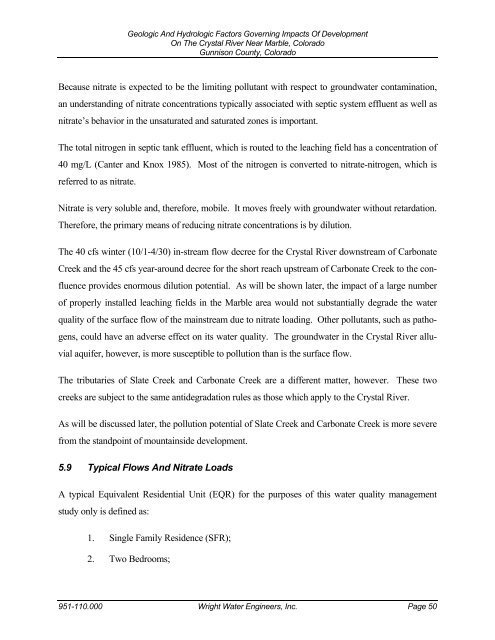Geologic And Hydrologic Factors Governing ... - Gunnison County
Geologic And Hydrologic Factors Governing ... - Gunnison County
Geologic And Hydrologic Factors Governing ... - Gunnison County
Create successful ePaper yourself
Turn your PDF publications into a flip-book with our unique Google optimized e-Paper software.
<strong>Geologic</strong> <strong>And</strong> <strong>Hydrologic</strong> <strong>Factors</strong> <strong>Governing</strong> Impacts Of Development<br />
On The Crystal River Near Marble, Colorado<br />
<strong>Gunnison</strong> <strong>County</strong>, Colorado<br />
Because nitrate is expected to be the limiting pollutant with respect to groundwater contamination,<br />
an understanding of nitrate concentrations typically associated with septic system effluent as well as<br />
nitrate’s behavior in the unsaturated and saturated zones is important.<br />
The total nitrogen in septic tank effluent, which is routed to the leaching field has a concentration of<br />
40 mg/L (Canter and Knox 1985). Most of the nitrogen is converted to nitrate-nitrogen, which is<br />
referred to as nitrate.<br />
Nitrate is very soluble and, therefore, mobile. It moves freely with groundwater without retardation.<br />
Therefore, the primary means of reducing nitrate concentrations is by dilution.<br />
The 40 cfs winter (10/1-4/30) in-stream flow decree for the Crystal River downstream of Carbonate<br />
Creek and the 45 cfs year-around decree for the short reach upstream of Carbonate Creek to the con-<br />
fluence provides enormous dilution potential. As will be shown later, the impact of a large number<br />
of properly installed leaching fields in the Marble area would not substantially degrade the water<br />
quality of the surface flow of the mainstream due to nitrate loading. Other pollutants, such as patho-<br />
gens, could have an adverse effect on its water quality. The groundwater in the Crystal River allu-<br />
vial aquifer, however, is more susceptible to pollution than is the surface flow.<br />
The tributaries of Slate Creek and Carbonate Creek are a different matter, however. These two<br />
creeks are subject to the same antidegradation rules as those which apply to the Crystal River.<br />
As will be discussed later, the pollution potential of Slate Creek and Carbonate Creek is more severe<br />
from the standpoint of mountainside development.<br />
5.9 Typical Flows <strong>And</strong> Nitrate Loads<br />
A typical Equivalent Residential Unit (EQR) for the purposes of this water quality management<br />
study only is defined as:<br />
1. Single Family Residence (SFR);<br />
2. Two Bedrooms;<br />
951-110.000 Wright Water Engineers, Inc. Page 50



